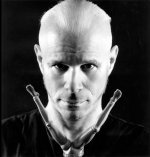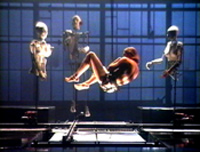Opening
Program  Installation Installation
 Program
1 Program
1  Program
2-3 Program
2-3  Program
4-5 Program
4-5  Program
6 Program
6  Program
7 Program
7  Program
8 Program
8  Program
9 Program
9  Program
10 Program
10  Program
11 Program
11  Program
12 Program
12  Program
13 Program
13  Program
14 Program
14  Closing
Ceremony Closing
Ceremony

Program 4-5: Dance Film
Artist in Focus: Charles Atlas
(St. Petersburg
- only)
 |
| photo
by Josef Astor
|
Charles
Atlas,
has been active as a filmmaker and video artist since the 1970s.
Over the years he has made pioneering media/dance works, multi-channel
video installations, feature-length documentaries, video art works
for television, and live electronic performances. Many of Atlas’
works have been made in collaboration with choreographers/ dancers.
He was filmmaker-in-residence with the Merce Cunningham Dance Company
from 1974-83, and collaborated with Cunningham to create many film/video
pieces, including Blue Studio (1976) and Channels/Inserts (1981).
In the 80s, Atlas created two acclaimed films commissioned by Channel
Four in London, featuring the work of British choreographer Michael
Clark, Hail the New Puritan (1986), and Because We Must (1989).
His film Merce Cunningham: A Lifetime of Dance (2000), a 90-minute
international co-production for television, won a “best documentary”
award at Dance Screen in Monaco. His most recent dance-related pieces
are Rainer Variations (2002), a video portrait of filmmaker/choreographer
Yvonne Rainer and two video/dance collaborations with Merce Cunningham:
Views On Camera (2005) and Views On Video (2005). Over the years,
he has collaborated with numerous other performers and choreographers
including James Waring, Douglas Dunn, Karole Armitage, Phillippe
Decoufle, DANCENOISE, Bill Irwin, John Kelly, Diamanda Galas, and
Stanley Love.
Among other works are several film and installation portraits of
fashion icon Leigh Bowery (2002); video sequences about the work
of the Judson Dance Theatre as part of the Mikhail Baryshnikov’s
White Oak Dance Project’s PastForward (2001); multi-media
performance/theater pieces including “Delusional” (1994)
created in collaboration with Marina Abramovic and large-scale gallery
installations – “The Hanged One” (1997), an imaginative
interpretation of the a Tarot card figure (The Hanged Man) was shown
at the Whitney Museum of American Art, and featured 15 channels
of video, programmed lighting, and kinetic sculptural elements.
Atlas is the 2006 recipient of the Foundation for Contemporary Art’s
biennial John Cage Award. He is also the recipient of three “Bessie”
(New York Dance and Performance) Awards, the most recent bestowed
in 1998 in recognition of video collages made for “Martha
@ Mother.”
Program
IV: Dance
Legends: Merce Cunningham
venue:
DOM KINO (St. Petersburg)
see schedule for Moscow and Ekaterinburg
Merce
Cunningham: A Life Time of Dance
(90min, USA, 2001)
Director: Charles Atlas
“A
Lifetime of Dance” tells a story of Merce Cunningham,
a visionary modern dance choreographer from the United States
revealing the artist’s groundbreaking ideas on modern
dance and art making. Interviews with the master, with his contemporaries
including early members of Cunningham’s dance company
(founded in 1953) as well as critics and historians interweave
with footage of his work. John Cage, whose percussive compositions
became a hallmark of the Cunningham style, is fondly recollected
by troupe members and Cunningham ("John Cage was just a
plain bright soul"). The film celebrates Cunningham’s
genius and his continuous artistic search for innovations bringing
the viewers into the 90s, when Cunningham in his 70s was once
again considered radical for incorporating computer technology
into choreography.
“Movement itself is the principal subject matter of his
dances: neither narrative nor musical form determines their
structure. His collaboration with the composer John Cage began
with Cunningham's first independent choreography, in 1942, and
lasted until Cage's death fifty years later. In the course of
their work together they proposed a number of radical innovations.
The most famous, and controversial, of these concerned the relationship
of dance and music. …Famously, the dancers in Cunningham's
company learn and rehearse a work in silence and often do not
hear the music until the first performance, or at any rate the
dress rehearsal. Other conventional elements of dance structure
were also abandoned: conflict and resolution, cause and effect,
climax and anti-climax. Cunningham is not interested in telling
stories or exploring psychological states. This does not mean
that drama is absent, but it arises from the intensity of the
kinetic and theatrical experience, and the human situation on
stage. Cunningham's dancers are not pretending to be anything
other than themselves-as he once said, "you are not necessarily
at your best, but at your most human." – David Vaughan
for American Masters Series
Program
V: An
evening with Charles Atlas
venue:
ProArte Institute
Charles Atlas
will discuss and screen numerous excerpts from films and videos
that he created throughout his prolific over thirty-year career.
“As seen on TV” (25min, 1988, USA) with the world
renown mime and comedian Bill Irwin will be shown in its entirety.
Excerpts from “Parafango” (1984) (with Phillip DeCoufle,
Michael Clark, Karole Armitage), “Superhoney” (1994),
“Oh, Misha” (1999) (a birthday present for Mikhail
Baryshnikov), “Because We Must” (1989) (with Michael
Clark) and many others will be part of the program.
“As Seen on TV”
(25min, 1988, USA)
Director: Charles Atlas in collaboration
with Bill Irwin
In “As
Seen On TV”, "new vaudevillian" performance
artist Bill Irwin is the subject of a wryly comic performance
narrative. Framed by the storyline of a parodic theatrical audition,
Irwin plays a hapless Everyman who inadvertently becomes trapped
inside a television set.
Displaying
an antic physical comedy that has been likened to a contemporary
rendering of Chaplin's Little Tramp, Irwin wanders, baffled,
through the television space, caught in the flow of televised
soap operas, commercials, sitcoms and ballets. This
narrative ploy allows Irwin and Atlas to demonstrate their respective
skills at constructing an ironic and inventive forum for contemporary
performance. - EAI
“Parafango”
(50min, 1989, USA) - excerpt
Director: Charles Atlas
Choreographer: Karole Armitage
Magnetic
performances by Karole Armitage, Michael Clark and Philippe
Découflé are the focus of this French production,
an intricate and quintessential Atlas pastiche of provocative
dance, new music, pop design and costuming, narrative, documentary,
and media references. Armitage's eclectic, often frenetic
choreography is performed with a postured insouciance. The
kinetically shot and edited dance segments are intercut
with an ambiguous narrative involving the performers, TV
news footage and other appropriated images, color bars and
other formal video devices. Atlas punctuates the physicality
of the dance with an artificial media reality. By rupturing
the performance illusion with deconstructive devices, Atlas
subjects this radically postmodern dance to an inquiry into
the tension between the fictive and the real. – EAI
“Superhoney”
(51min, 1984, USA) - excerpt
Director: Charles Atlas, Choreographer:
Thomas Hejlesen
 In
this futuristic danse macabre, Atlas creates a fully realized
cyber-gothic world, rife with both erotic and physical danger.
We follow our heroine on her travels through a world inhabited
by libidinal robots, human profligates, statuesque hairdressers
and a bevy of other intriguing individuals. Her stylized
and blank-faced nonchalance mirror the performative passion
and violence which surrounds her. In SUPERHONEY Atlas unhinges
his own well-developed aesthetic in order to more fully
explore the interplay between ambivalence and pleasure.
- EAI In
this futuristic danse macabre, Atlas creates a fully realized
cyber-gothic world, rife with both erotic and physical danger.
We follow our heroine on her travels through a world inhabited
by libidinal robots, human profligates, statuesque hairdressers
and a bevy of other intriguing individuals. Her stylized
and blank-faced nonchalance mirror the performative passion
and violence which surrounds her. In SUPERHONEY Atlas unhinges
his own well-developed aesthetic in order to more fully
explore the interplay between ambivalence and pleasure.
- EAI
“Because
we must” (50min, 1989, USA) - excerpt
Director: Charles Atlas, Choreographer:
Michael Clark
In “Because
We Must”, Atlas continued his collaboration with British
choreographer Michael Clark, the enfant terrible of the
dance world in the 1980s. Based on an original stage production
at Sadlers' Wells Theatre in London, this is an ironic,
irreverent work that is as entertaining as it is provocative.
The extravagant stylization and burlesque humor that pervade
the choreography, costuming and staging are mirrored by
Atlas' focus on the theatricality of the performance and
the artifice of the behind-the-scenes narrative. Clark thumbs
his nose at the conventions of "serious" dance,
composing outrageously unexpected and inventive scenarios
that include a nude dancer wielding a chain-saw and a psychedelic
interlude, all exquisitely if ironically performed. - EAI
Opening
Program  Installation Installation
 Program
1 Program
1  Program
2-3 Program
2-3  Program
4-5 Program
4-5  Program
6 Program
6  Program
7 Program
7  Program
8 Program
8  Program
9 Program
9  Program
10 Program
10  Program
11 Program
11  Program
12 Program
12  Program
13 Program
13  Program
14 Program
14  Closing
Ceremony Closing
Ceremony
© Kinodance–Russia, 2006
akovgan@kinodance.com
|

